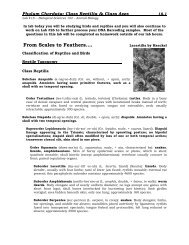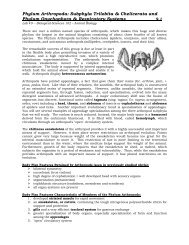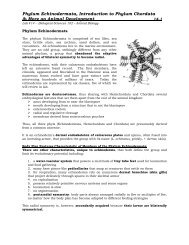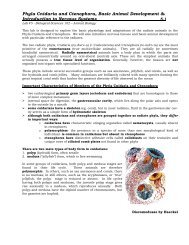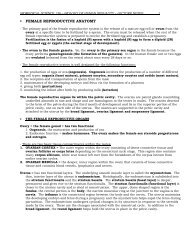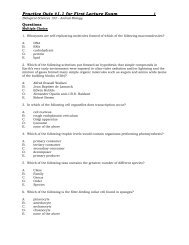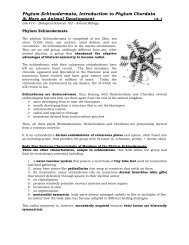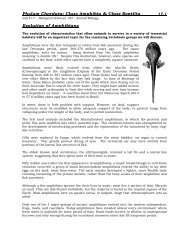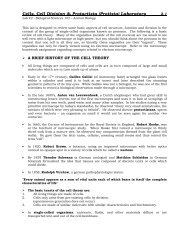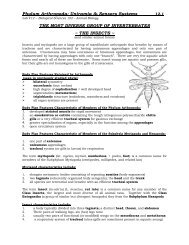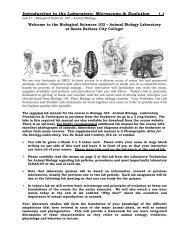Phyla Cnidaria and Ctenophora, Basic Animal Development ...
Phyla Cnidaria and Ctenophora, Basic Animal Development ...
Phyla Cnidaria and Ctenophora, Basic Animal Development ...
Create successful ePaper yourself
Turn your PDF publications into a flip-book with our unique Google optimized e-Paper software.
<strong>Phyla</strong> <strong>Cnidaria</strong> <strong>and</strong> <strong>Ctenophora</strong>, <strong>Basic</strong> <strong>Animal</strong> <strong>Development</strong> &<br />
Introduction to Nervous Systems 5.3<br />
Lab #5 - Biological Sciences 102 – <strong>Animal</strong> Biology<br />
<strong>Basic</strong> <strong>Animal</strong> Life Cycles & <strong>Development</strong> (Embryology)<br />
On the chalkboard, your instructor will diagram a basic, generalized animal lifecycle to<br />
introduce the following terms related to animal life cycles <strong>and</strong> development. Your instructor<br />
will then review with you the basic life cycle of the cnidarians, Obelia sp. <strong>and</strong> Aurelia aurita as<br />
specific examples.<br />
EARLY ANIMAL DEVELOPMENT (see diagrams from board)<br />
sperm = the male gamete (haploid = N)<br />
ovum (egg) = the female gamete (haploid = N)<br />
fertilization = the species specific binding of the sperm to the egg <strong>and</strong> fusion of the<br />
sperm cell nucleus with the egg cell nucleus to create a diploid zygote<br />
zygote = fertilized egg (diploid = 2N)<br />
cleavage = the mitotic cell divisions of an animal zygote; the first cell divisions that<br />
occur to create a morula from the zygote<br />
morula = a solid ball of cells that froms from the mitotic divisions of the zygote<br />
blastula = the next embryonic stage that marks the end of early cell division during<br />
animal development; an embryo that look like a hollow ball of cells<br />
gastrula = the next embryonic stage resulting from the division of the early cells into<br />
three major tissue types during early animal development. The gastrula may have two<br />
(endoderm & ectoderm only) or three tissue layers (ectoderm, mesoderm, & endoderm)<br />
gastrulation = the process that leads to the formation of a gastrula<br />
ectoderm = the outer layer of three embryonic cell layers in a gastrula; forms the skin<br />
of the gastrula <strong>and</strong> gives rise to the epidermis <strong>and</strong> nervous system of the adult<br />
mesoderm = the middle layer of the three embryonic cell layers in a gastrula; gives rise<br />
to muscles, bones, the dermis of the skin, <strong>and</strong> many other organs in the adult<br />
endoderm = the innermost of three embryonic cell layers in a gastrula; forms the gut of<br />
the gastrula <strong>and</strong> gives rise to the innermost linings of the digestive tract <strong>and</strong> other<br />
hollow organs (e.g. lungs) in the adult<br />
larvae = an immature animal life stage that is significantly different from the adult <strong>and</strong><br />
usually incapable of sexual reproduction<br />
metamorphosis = a drastic change in form during postembryonic development from<br />
the larval stage to another form, usually the adult<br />
adult = the sexually mature form of an animal<br />
Cleavage, the earliest stage in embryonic development, consists of a succession of regular<br />
mitotic cell divisions that partition the egg into a multitude of small cells clustered together. In<br />
lower animals, cleavage is so rapid that hundreds, sometimes thous<strong>and</strong>s, of cells are produced<br />
in a matter of hours.



